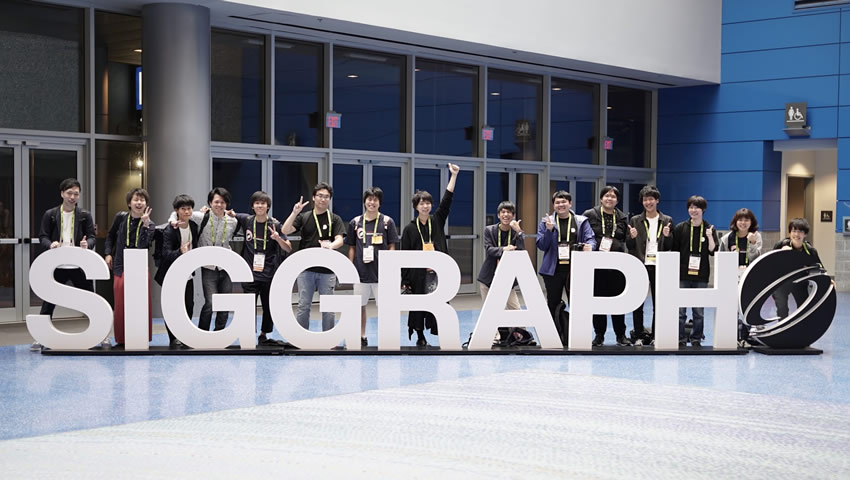SIGGRAPH Asia Tokyo is fast approaching, Bektur Ryskeldiev from the SIGGRAPH International Resources Committee interviewed Yoichi Ochiai who provides a great insight into the culture behind computer graphics in Japan. Yoichi, who has a background in computer science, is part of the Digital Nature Group at the University of Tsukuba. Yoichi prefers to work with physical applications such as optics or laser optics combining both CG and applied physics. “Currently, I am working with holographic synthesis using optical and acoustic waves, designing new kinds of human interfaces through applications of computer graphics.”
Yoichi became involved with SIGGRAPH in his second year of university, which inspired him to enroll in a PHD program.
SIGGRAPH’s Bektur Ryskeldiev (SIGGRAPH): Aside from SIGGRAPH you had a lot of experience working in international companies and communities. How would you compare Japanese academia and industry to the rest of the world? What is your experience of working abroad?
Yoichi Ochiai (YO): In June (2018), I was involved in Google X Camp, which gathered scientists from all over the world. We discussed science-based research questions and how to deploy the resulting technologies in society or citizen science. Each time I attend an international event I notice a difference in the way International people approach discussion compared with the Japanese. Discussion in international communities focuses on the topic. There is a common research question or a problem, and everybody works towards the discussion topic.
in Japan, however, especially in local communities where we share a common background, everybody assumes that we share the same experience and because of that, discussion starts on a high or even meta level, so we focus on mood or relationships. We don’t say too much as we assume that everyone has the same level of understanding.
SIGGRAPH: Since you mention that the Japanese community is somewhat enclosed, what kind of topics are popular in your area of work in Japan?
YO: In the Japanese community right now we are facing many problems related to an aging society. We are researching the applications of AR/VR and telepresence towards addressing this issue. Computational resources can decrease costs and are easy to deploy. For instance, using smartphones or laptops is so much cheaper and easier to deploy in comparison with specific hardware or stationary systems.
When I was an elementary school student, we learnt that we are in the age of a decreasing population. That’s why the primary goal for technology is how to make life better for an aging society in local communities. Because of such problems, we use computer graphics not only for entertainment, but also for practical solutions.
SIGGRAPH: For people who want to work in Japan, are there any topics or disciplines they should be considering?
YO: In Japan, the applications of computer science for the augmentation of human abilities and skills, or applications that compensate for the decrease in the workforce are [currently] very important for Japanese society.
Also anything to do with computer science in general! Japan has built its nation by developing hardware. However, in the last 25 years we haven’t had much success in hardware development. Despite being focused on hardware for the past 60 years, society needs to focus on how to design the software itself. Because of this, computer science people are required everywhere, in every division of any company.
SIGGRAPH: SIGGRAPH Asia is coming to Tokyo this year, 4-7 December, 2018 at the Tokyo International Forum. Are there any other reasons to visit Tokyo except for going to SIGGRAPH Asia?
YO: Tokyo is one of the most exciting cities. It is densely populated, has a lot of great food and entertainment. Tokyo has also a good mixture of Eastern, European, and Industrial cultures. In the 20th century we invented cutting-edge cars and consumer electronic products, and now they are installed everywhere amongst the tall buildings where people live and work. At the same time we have a lot of old festivals and temples.
It is a mix of old and new, because Tokyo was rebuilt 3 times during its recent history. First, during the Edo period, then the Meiji period, and again after World War II. Now it is facing its next redesign after the 2020 Olympic Games, because now we look towards the next paradigm for our society: how to change our industrial society towards Society 5.0. Right now is a good time to have a dream or a desire to design the physical world, communities, or cities through computational resources, computer graphics, or the internet of things.
We are looking for ways to design communities through software platforms rather than hardware platforms. That’s why we are trying to understand how we can design nature, or how we can design environments through computer science. It is a good research question for our society to explore. SIGGRAPH Asia in Tokyo is a good occasion for Japanese researchers and communities to discuss the next computational development goals, before the Tokyo 2020 Olympic Games.
SIGGRAPH: Is there anything else you would like to say to our readers?
YO: My first SIGGRAPH was in 2008, and this SIGGRAPH is happening in 2018. In a way it is my SIGGRAPH anniversary. The opportunity to discuss crazy things at SIGGRAPH is very precious for me. So if you find someone in the SIGGRAPH conference hall that wears long black clothes and speaks broken English, please say hello to me. I think you can find me easily around the SIGGRAPH conference venue.



